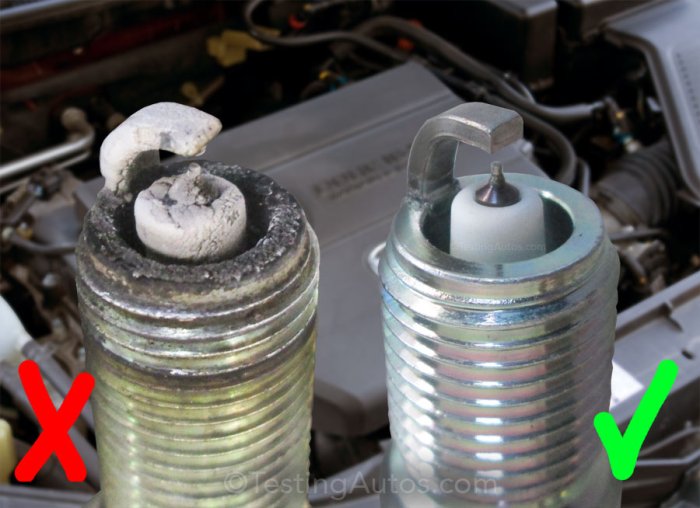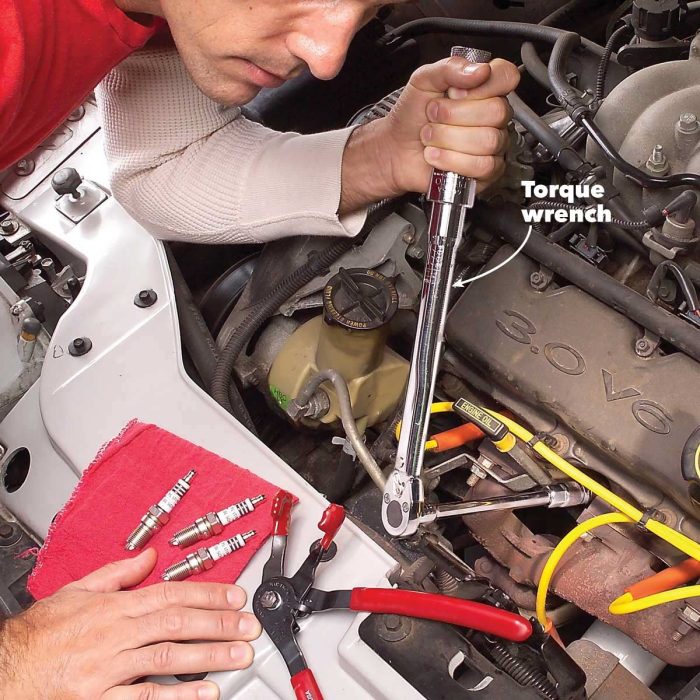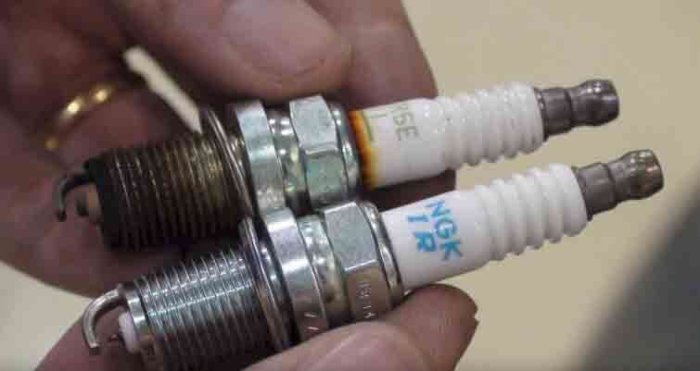Best time to replace spark plugs? It’s not just about mileage; your driving habits, fuel quality, and even the type of engine you have all play a role. Ignoring the signs of failing spark plugs can lead to decreased fuel efficiency, rough idling, and even engine damage, so understanding when to swap them out is key to keeping your ride running smoothly and saving you money in the long run.
This guide will break down everything you need to know about spark plug replacement, from recognizing the warning signs to choosing the right plugs and performing the replacement yourself.
We’ll cover the average lifespan of different spark plug types, the impact of your driving style, and how to identify when it’s time for a change. We’ll also walk you through the process of replacing them, offering step-by-step instructions and tips for ensuring you do it right. Finally, we’ll compare the costs of different spark plug types and professional versus DIY replacement, helping you make the best decision for your car and your wallet.
Factors Influencing Spark Plug Replacement

So, you’re wondering when to swap out those spark plugs? It’s not just about hitting a mileage marker; a bunch of factors play into it. Think of it like this: your spark plugs are tiny but mighty parts, crucial for your engine’s smooth operation, and their lifespan depends on a whole lot more than just time. Let’s break down what influences how long they last.
Average Lifespan of Various Spark Plug Types, Best time to replace spark plugs
Spark plug lifespan varies wildly depending on the type. Copper plugs, the most basic, usually last around 25,000 to 30,000 miles. Platinum plugs are a step up, lasting 60,000 to 100,000 miles due to their more durable electrode. Iridium plugs, the top dogs, can often go for a whopping 100,000 miles or even more, thanks to their incredibly resilient material.
Keep in mind, these are just averages; individual experiences can differ. For example, a car driven primarily in stop-and-go city traffic might wear down plugs faster than one cruising on the highway.
Driving Habits and Spark Plug Longevity
Your driving style significantly impacts how long your spark plugs last. Aggressive acceleration and frequent hard braking create more stress on the engine, leading to faster wear and tear on the plugs. Short trips, where the engine doesn’t get fully warmed up, also contribute to premature failure. Think about it – constantly starting and stopping your car doesn’t give the engine a chance to reach optimal operating temperature, and this can cause moisture build-up and fouling.
Conversely, consistently driving at a steady pace on the highway generally extends spark plug life.
Fuel Quality and Spark Plug Performance
Dirty fuel can really mess with your spark plugs. Low-quality fuel often contains impurities that can foul the plugs, reducing their effectiveness and lifespan. Using premium fuel, especially in high-performance engines, can help maintain cleaner plugs and improve performance, though the added cost needs to be weighed against the potential benefit. The type of fuel you use, such as regular, mid-grade, or premium, can also impact plug life, with higher-octane fuels potentially leading to longer lifespan in some cases.
Engine Type and Size: Determining Replacement Intervals
The type and size of your engine are key factors. Smaller engines, generally found in compact cars, often have shorter spark plug replacement intervals than larger engines in trucks or SUVs. This is because smaller engines may operate at higher RPMs more frequently, leading to increased wear. Also, different engine designs (like those with turbochargers or superchargers) might demand more frequent replacements due to the increased stress on the spark plugs.
Always consult your owner’s manual for recommendations specific to your vehicle.
Warning Signs of Spark Plug Replacement
Ignoring signs of failing spark plugs can lead to bigger engine problems. Here’s a breakdown of common symptoms:
| Symptom | Description | Severity | Recommended Action |
|---|---|---|---|
| Rough Idle | Engine shakes or vibrates noticeably at idle. | Moderate | Inspect spark plugs; replace if necessary. |
| Misfires | Engine stumbles, hesitates, or loses power. | High | Immediate inspection and replacement of faulty plugs. |
| Reduced Fuel Efficiency | Noticeably lower gas mileage than usual. | Moderate | Check spark plugs as a possible contributing factor. |
| Difficult Starting | Engine cranks for longer than usual before starting. | Moderate | Inspect spark plugs for wear and fouling. |
Recommended Replacement Intervals

So, you’ve figured out
why* you might need new spark plugs, but now the big question is
when*? There’s no single magic number, unfortunately. Spark plug lifespan depends on a lot of factors, as we discussed earlier, but we can give you some general guidelines and manufacturer recommendations to help you make the best decision for your ride.Knowing when to replace your spark plugs is crucial for maintaining your engine’s performance and longevity. Ignoring recommended replacement intervals can lead to decreased fuel efficiency, rough idling, misfires, and even engine damage.
Let’s dive into the specifics.
Spark Plug Replacement Intervals by Vehicle
The following table providesgeneral* recommended replacement intervals. Keep in mind that these are just estimates, and your vehicle’s owner’s manual should always be your primary source of information. Severe driving conditions (like lots of stop-and-go traffic or towing) can significantly shorten the lifespan of your spark plugs.
| Vehicle Make/Model | Recommended Mileage (miles) | Recommended Time (Years) |
|---|---|---|
| Toyota Camry (2018-2023) | 60,000 – 100,000 | 3-5 |
| Honda Civic (2016-2021) | 60,000 – 100,000 | 3-5 |
| Ford F-150 (2015-2020) | 30,000 – 60,000 | 2-4 |
| Chevrolet Silverado (2019-2023) | 30,000 – 60,000 | 2-4 |
| Subaru Outback (2020-2024) | 60,000 – 100,000 | 3-5 |
*Note: This is a sample; actual recommendations vary widely.* Always check your owner’s manual for the most accurate information for your specific vehicle.
Gasoline vs. Diesel Engine Differences
Gasoline and diesel engines have different combustion processes, leading to varying spark plug (or glow plug in diesel’s case) lifespans. Gasoline engines typically require spark plug replacements more frequently than diesel engines. Diesel engines use glow plugs to ignite the fuel-air mixture, and these glow plugs generally last much longer, often exceeding 100,000 miles under normal operating conditions.
However, even diesel glow plugs eventually need replacing and their failure can cause significant starting problems.
Manufacturer Recommendations vs. General Guidelines
Manufacturer recommendations, found in your owner’s manual, are always the best starting point. They are tailored to your specific vehicle’s engine design and operating parameters. General guidelines, like those found online or in this document, offer a broader range, but they may not account for specific factors affecting your vehicle. Sticking to the manufacturer’s recommendations minimizes the risk of premature wear or engine damage.
Consequences of Delayed Spark Plug Replacement
Ignoring recommended replacement intervals can lead to a variety of problems, from minor annoyances to major engine damage. Delayed replacement can result in: reduced fuel efficiency (your car is working harder), rough idling (that annoying shake), misfires (loss of power and potential damage), increased emissions (bad for the environment and your wallet), and even catastrophic engine failure (expensive!). For example, a misfire caused by worn spark plugs can lead to overheating and damage to catalytic converters, resulting in costly repairs.
So, you’re wondering about the best time to replace spark plugs? Generally, it’s recommended to check them around 30,000 miles, but it depends on your car. If you’re driving a fancy new 2025 Mercedes-Benz, though, you might want to check out Best extended warranty for Mercedes-Benz 2025 to cover any unexpected repairs. That way, even if your spark plugs need replacing sooner than expected, you’re covered.
Back to spark plugs, regular maintenance is key to keeping your engine running smoothly.
Regular maintenance, including timely spark plug replacement, is key to preventing these issues and keeping your vehicle running smoothly and efficiently.
The Spark Plug Replacement Process
Replacing your spark plugs might seem daunting, but with the right tools and a little know-how, it’s a manageable DIY project that can significantly improve your engine’s performance. This process is pretty straightforward, but always remember to consult your vehicle’s repair manual for specific instructions and torque specifications. Safety first!
This section details the step-by-step process of spark plug replacement, the importance of proper gap adjustment, how to inspect used plugs, and safe disposal methods.
Spark Plug Replacement Steps
Before you begin, gather your tools. You’ll need a socket wrench (usually 5/8″ or 13/16″, depending on your vehicle), a spark plug socket (to avoid damaging the plugs), a ratchet, a gap tool, a wire brush, dielectric grease (optional but recommended), and new spark plugs, of course! It’s also a good idea to have some rags or shop towels handy to clean up any oil or grease.
- Disconnect the battery’s negative terminal. This is crucial for safety to prevent accidental shorts or shocks.
- Locate the spark plugs. Consult your vehicle’s repair manual for their location. They’re usually under a plastic cover or part of the engine’s valve cover.
- Remove the spark plug wires. Carefully pull each wire straight off the plug, noting which wire goes to which cylinder. Sometimes it helps to take a picture for reference.
- Remove the spark plugs. Use the spark plug socket and ratchet to carefully remove each plug. Avoid cross-threading.
- Inspect the old spark plugs. (See the section below on inspecting used spark plugs.)
- Clean the spark plug wells. Use a wire brush to clean out any debris or carbon buildup from the spark plug wells. This ensures a good seal for the new plugs.
- Install the new spark plugs. Carefully screw in the new plugs by hand until they are snug. Then use the socket and ratchet to tighten them to the manufacturer’s specified torque. Over-tightening can damage the threads.
- Reconnect the spark plug wires. Make sure each wire is securely connected to the correct spark plug.
- Reconnect the battery’s negative terminal.
- Start the engine and check for any issues. Listen for any unusual sounds or check for any misfires.
Spark Plug Gap Adjustment
The spark plug gap is the distance between the center electrode and the ground electrode. A properly gapped plug is essential for optimal ignition and engine performance. An incorrect gap can lead to misfires, poor fuel economy, and even engine damage. The correct gap is specified by the manufacturer and is usually found in your vehicle’s owner’s manual or on the spark plug packaging.
It’s typically measured in millimeters or thousandths of an inch.
Use a gap tool to adjust the gap. Gently bend the ground electrode to achieve the correct spacing. Always refer to the manufacturer’s specifications for the correct gap measurement. Too wide a gap can cause misfires due to the increased distance the spark needs to jump, while too narrow a gap can lead to overheating and premature plug failure.
Used Spark Plug Inspection
Visually inspecting used spark plugs can provide valuable insights into the health of your engine. Here are some common conditions you might observe:
- Normal Wear: The electrode shows slight wear, but the insulator is clean and white or light tan. This indicates proper combustion.
- Oil Fouling: The insulator is covered in a dark, oily substance. This suggests excessive oil consumption or a problem with the valve seals or piston rings.
- Carbon Fouling: The insulator is covered in a black, sooty deposit. This usually points to a rich fuel mixture (too much fuel relative to air), possibly due to a faulty air-fuel sensor or a problem with the carburetor or fuel injectors.
- Lean Fouling: The insulator is white or light gray, but very dry and brittle. This indicates a lean fuel mixture (too much air relative to fuel), potentially due to a problem with the fuel delivery system.
- Electrode Wear: Significant wear on the electrodes, with the center electrode being significantly eroded or the gap being much larger than specified. This suggests the plugs have reached the end of their lifespan and need replacing.
Used Spark Plug Disposal
Used spark plugs contain small amounts of hazardous materials. Therefore, it’s important to dispose of them properly. Don’t throw them in the regular trash. Most auto parts stores and recycling centers accept used spark plugs for recycling or proper disposal. Check with your local waste management facility for specific guidelines in your area.
Types of Spark Plugs and Their Suitability
Choosing the right spark plug for your vehicle is crucial for optimal engine performance, fuel efficiency, and longevity. Different spark plug types offer varying levels of performance, lifespan, and cost, making the selection process important for both casual drivers and performance enthusiasts. Understanding these differences can help you make an informed decision and avoid potential issues down the road.
Spark Plug Type Comparison
The table below compares three common spark plug types: copper, platinum, and iridium. These differences stem from the materials used in the electrode construction, impacting their durability, performance, and ultimately, their price.
So, you’re wondering about the best time to replace spark plugs? Generally, it’s recommended to check your owner’s manual, but while you’re at it, you might also want to check the cabin air filter; it’s super easy to forget! If you’re driving a Ford F-150, check out this link to see the average Cost to replace cabin air filter in Ford F-150 – then get back to those spark plugs; neglecting them can seriously impact your gas mileage.
| Spark Plug Type | Performance Characteristics | Lifespan (miles) | Cost |
|---|---|---|---|
| Copper | Good ignition, relatively inexpensive. Can be prone to erosion, leading to performance degradation over time. | 20,000 – 30,000 | Low |
| Platinum | Improved lifespan compared to copper due to the harder platinum electrode. Offers better ignition performance than copper, particularly at higher mileage. | 60,000 – 100,000 | Medium |
| Iridium | Superior ignition performance and extremely long lifespan thanks to the incredibly durable and fine iridium tip. Provides a stronger, more consistent spark. | 100,000+ | High |
Benefits and Drawbacks of Each Type
Copper spark plugs are the most economical option, making them a popular choice for budget-conscious drivers. However, their shorter lifespan necessitates more frequent replacements. Platinum spark plugs offer a significant increase in lifespan compared to copper, justifying their higher cost over the long run. Iridium spark plugs represent the top tier, offering exceptional performance and longevity, but come with a higher initial investment.
Consequences of Incorrect Spark Plug Selection
Using the wrong type of spark plug can lead to a variety of problems. For instance, installing a spark plug with a heat range too hot for your engine could lead to pre-ignition or even engine damage. Conversely, a spark plug with a heat range that’s too cold might cause fouling and misfires. Ultimately, choosing the wrong spark plug can compromise engine performance, fuel economy, and emissions.
Specialized Spark Plugs for High-Performance Applications
High-performance engines often require specialized spark plugs designed to withstand the extreme conditions of high RPMs, boost pressure, and intense heat. These specialized plugs may feature features like multiple electrodes, different ground strap designs, or materials engineered for higher thermal conductivity. For example, racing applications might utilize spark plugs with a very fine electrode tip for enhanced ignition precision under extreme loads.
The choice of spark plug in these cases is critical for optimal engine performance and reliability.
Cost Considerations: Best Time To Replace Spark Plugs

Replacing spark plugs might seem like a small expense, but the total cost can vary significantly depending on the type of plugs you choose and whether you perform the replacement yourself or hire a mechanic. Understanding these cost factors can help you make informed decisions and potentially save money in the long run.
The price of spark plugs ranges widely, influenced by factors like material quality, design, and brand reputation. Higher-quality plugs often use more durable materials and advanced designs, leading to a longer lifespan and potentially better engine performance. However, this comes at a higher initial cost. Conversely, cheaper plugs might seem attractive upfront, but they may require more frequent replacements, ultimately costing you more over time.
Spark Plug Cost Comparison
The following table illustrates the price differences between various spark plug types for a typical 4-cylinder engine. These are average prices and can fluctuate based on retailer and specific brand.
| Spark Plug Type | Average Cost per Unit | Total Cost for a 4-Cylinder Set |
|---|---|---|
| Standard Copper Core | $2 – $4 | $8 – $16 |
| Platinum | $8 – $15 | $32 – $60 |
| Iridium | $15 – $30 | $60 – $120 |
Professional Spark Plug Replacement Costs
Labor costs for professional spark plug replacement can vary depending on your location, the mechanic’s hourly rate, and the vehicle’s make and model. Some shops might charge a flat rate for the service, while others bill by the hour. Expect to pay anywhere from $50 to $200 or more, depending on these factors. This cost includes the mechanic’s time, disposal of old plugs, and potentially other minor adjustments or inspections.
DIY vs. Professional Replacement: A Cost Analysis
A DIY approach can significantly reduce the overall cost. For a 4-cylinder engine, the cost of a set of standard copper core plugs might be $8-$16, while the labor cost for a professional replacement could easily exceed this amount. However, DIY requires time, tools, and some mechanical aptitude. If you lack the necessary skills or tools, the risk of damaging your engine could outweigh the cost savings.
Consider the value of your time and the potential repair costs from a DIY mistake when weighing your options.
Long-Term Cost Savings with Higher-Quality Spark Plugs
While higher-quality spark plugs like platinum or iridium have a higher initial cost, their longer lifespan can lead to significant long-term savings. These plugs often last twice as long or more than standard copper core plugs, reducing the frequency of replacements and associated labor costs. Furthermore, improved performance and fuel efficiency can offer additional indirect cost savings over the lifespan of the plugs.
For example, if higher-quality plugs improve fuel economy by even a small percentage, those savings will accumulate over thousands of miles driven.
Conclusion
So, the best time to replace your spark plugs isn’t a single number on the odometer; it’s a combination of factors. By understanding your car’s needs, recognizing warning signs, and choosing the right plugs, you can ensure your engine runs efficiently and reliably for years to come. Whether you’re a seasoned DIYer or prefer professional service, this guide equipped you with the knowledge to make informed decisions about your spark plug replacement.
Remember to check your owner’s manual for specific recommendations for your vehicle, and don’t hesitate to consult a mechanic if you’re unsure about any aspect of the process.









